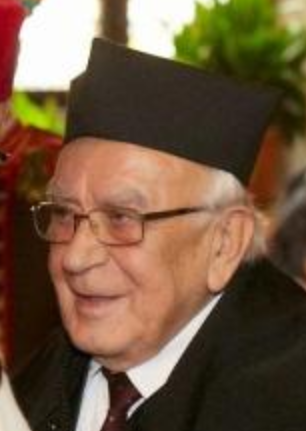 Jósef Masłowski (Photo courtesy of Krzysztof Magda)
Jósef Masłowski (Photo courtesy of Krzysztof Magda)
Jósef Masłowski
Contributed by Krzysztof Chyży and Richard Wielebinski
Jósef Masłowski was born on February 22nd, 1931, in Skomielna Biała (southern Poland) and passed away on January 23rd, 2020, in Kraków. He was the pioneer of Kraków's radio astronomy and strongly influenced its development.
He graduated from the Jagiellonian University in Kraków in 1955, obtaining a M.Sc. in astronomy. In the same year, he began his work as an assistant at the Jagiellonian University Astronomical Observatory, participating in research on celestial mechanics. At the same time, he also completed his engineering studies in electronics at the Academy of Mining and Metallurgy (now AGH University of Science and Technology) in Kraków. He defended his doctoral dissertation "Determination of lunar physical libration constants and the figure of the Moon from the first half of Hartwig's Bamberg series" at the Jagiellonian University in 1964. After his doctorate, he devoted himself entirely to radio astronomy, a new field of astronomical research at the time, making use of his extensive knowledge of astronomy and electronics. He played a key role in the construction and outfitting of the 15m radio telescope which went into operation at the Kraków Observatory in 1968. In later years (1989-1993), when he was Director of the Observatory, he initiated and supervised the construction of an 8m radio telescope for automatic monitoring of radio activity of the Sun, which is still operational.
In 1967, Joe published his first significant research paper in which he attempted to classify all non-galactic radio sources with known redshifts. Thanks to favourable circumstances, in 1969 (when travelling abroad could be merely dreamed of by Polish citizens), the former Director of the Jagiellonian University Astronomical Observatory, Professor Eugeniusz Rybka, arranged a 1.5-year scientific visit to the National Radio Astronomical Observatory (NRAO) in the United States. At the end of November 1969 Jósef Masłowski left for the NRAO to carry out his own research program. His return to Krakow in 1971 changed the status of radio astronomy at the Observatory, which became the leading field of research, ending the era of predominance of celestial mechanics.
During his time at NRAO, Masłowski used the 300-foot telescope to make a radio survey of the sky at centimetre waves, discovering about 600 new radio sources. The area was selected to cover two limited fields previously observed with the Cambridge (UK) One-Mile Telescope on longer radio wavelengths. This enabled him to make counts of radio sources as well as to find anisotropy in their distribution. This was a most important result, which was to be confirmed much later, showing that the galaxies, which include most baryonic matter in the Universe, are not distributed evenly throughout space, but form a structure that is now called a cosmic web. These achievements constituted the basis of his habilitation, which he received in 1974 at the Jagiellonian University as the first scientist in Kraków to be habilitated in radio astronomy. In 1978-1979, he was invited as a visiting professor to the Max-Planck-Institut für Radioastronomie in Bonn, where he continued his investigations of spectral and morphological properties of radio sources. In 1987 he went again to NRAO for 3 months and observed a subsample of sources with high resolution (of 1 arcsec) using the Very Large Array at 5 GHz, which allowed for detailed studies of their morphologies.
His first trip to the US was enormously consequential for the further development of radio astronomy in Kraków due to establishing a close cooperation with the world's leading radio astronomical centres. Jósef Masłowski generously used his achievements and contacts to promote his junior colleagues in major foreign scientific institutions, thus creating a large team of loyal colleagues at radio observatories in the US, Germany, the Netherlands and India, who pursued their own research on topics such as polarization of radiation and magnetic fields. As part of this collaboration, for instance, from 1974 to 1989, Jerzy Machalski made two sky surveys, GB2 and GB3, using the NRAO 300-foot radio telescope at 21cm wavelength. He later obtained one of the first high-resolution observations of radio source structures using the then new Very Large Array. As a master and tutor, Jósef Masłowski supervised five Ph.D. candidates, four of whom later received habilitation and some became professors. He was granted his own title of Professor of Physical Sciences in astronomy in 1987.
Joe successfully combined his scientific activities with other duties such as the involvement in development of radio astronomical instrumentation in Kraków. For several terms, he was Director of the Jagiellonian University Astronomical Observatory (1979-1984 and 1989-1999), and for 20 years was Head of the Department of Radio Astronomy and Space Physics (1978-1998). For many years (1978-1998) he was the Editor-in-Chief of the scientific journal Acta Cosmologica. He was also a member of several scientific societies, including IAU, URSI, and the Astrophysics Committee of the Polish Academy of Arts and Sciences in Kraków. For his contributions to Polish science, he was awarded a number of state honours and distinctions.
Privately, Jósef Masłowski was an extremely warm and kind man. These features of his personality were emphasized by many people he met both in Poland and abroad. He was a brilliant scientist and organizer of science, a very talented and cordial colleague and collaborator. Even long after his retirement, he often came to the Observatory to find out about new members on the staff, current research activities, and everything that was happening at the Institute that was so close to his heart.
![[IAU logo]](iau_wb_thumb.jpg)
![[URSI logo]](URSI-logo-thumb.jpg)
![[Karl Jansky at his antenna]](jansky_photo_02_thumb.jpg)
![[Reber's Wheaton antenna]](Reber_Telescope_Wheaton_thumb.jpg)
![[Dover Heights]](Dover_Heights_02_thumb.jpg)
![[4C telescope]](GB61-195_4C_telescope_thumb.jpg)
![[Ewen and horn antenna]](ewen_horn1s.jpg)
![[Dwingeloo, 1956]](Dwingeloo-1956-thumb.jpg)
![[Jocelyn Bell Burnell and Cambridge antenna used in pulsar discovery]](burnell2_thumb.jpg)
![[Lovell Telescope at Jodrell Bank]](site_1594_0001-500-334-20180316163019-thumb150.jpg)
![[Wilson, Penzias, and Bell Labs horn antenna]](wilson-penzias-horn_thumb.jpg)
![[6-m Millimeter Radio Telescope in Mitaka, Japan]](6m-thumb.jpg)

